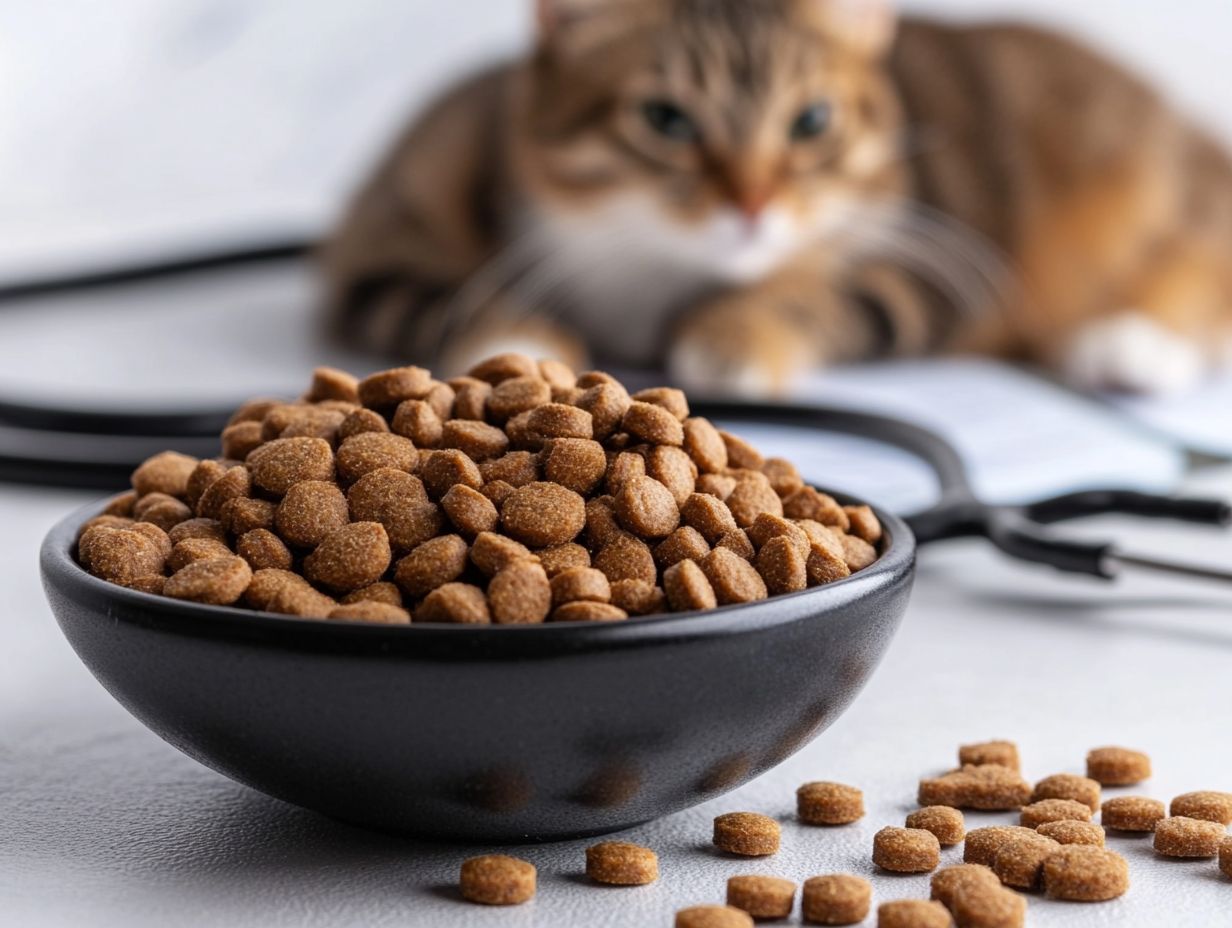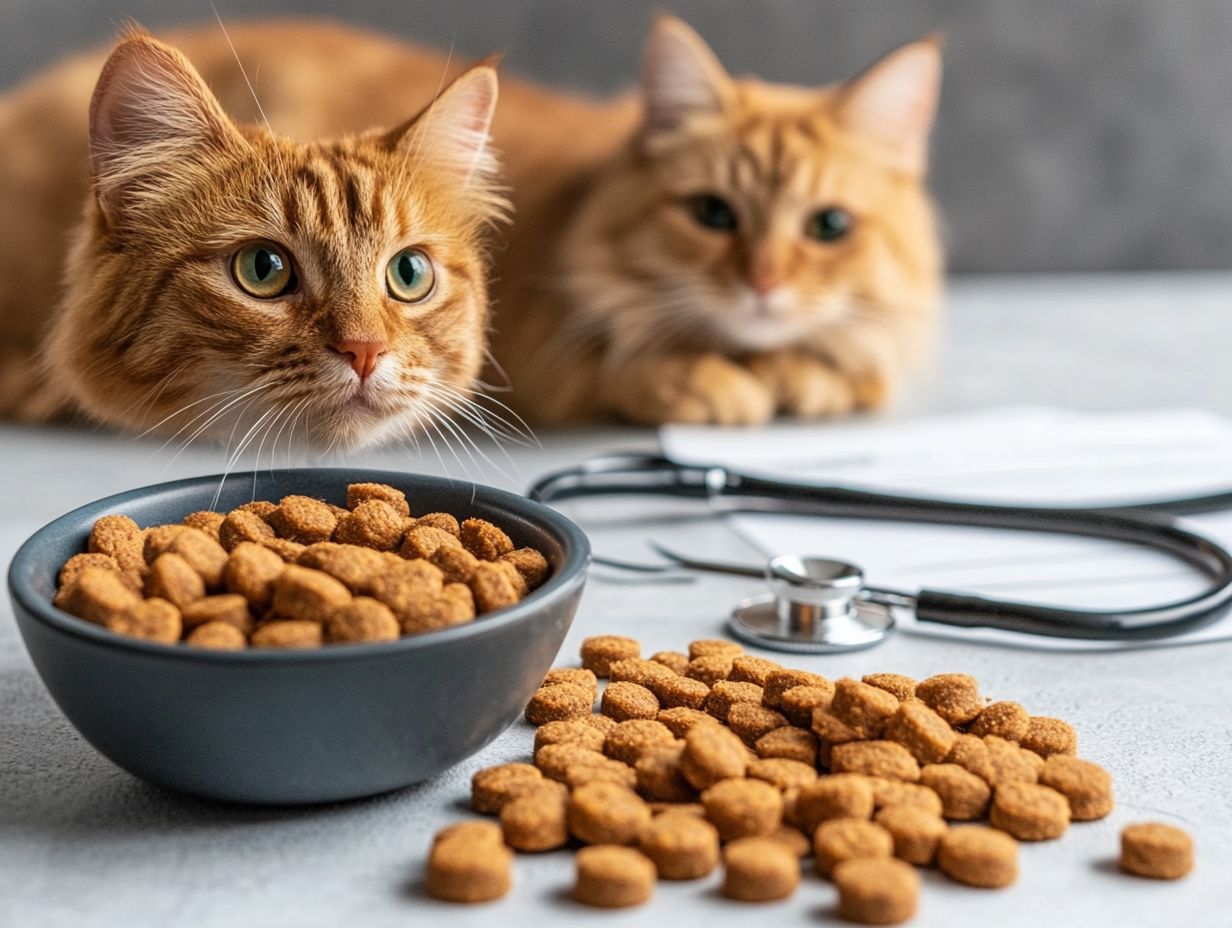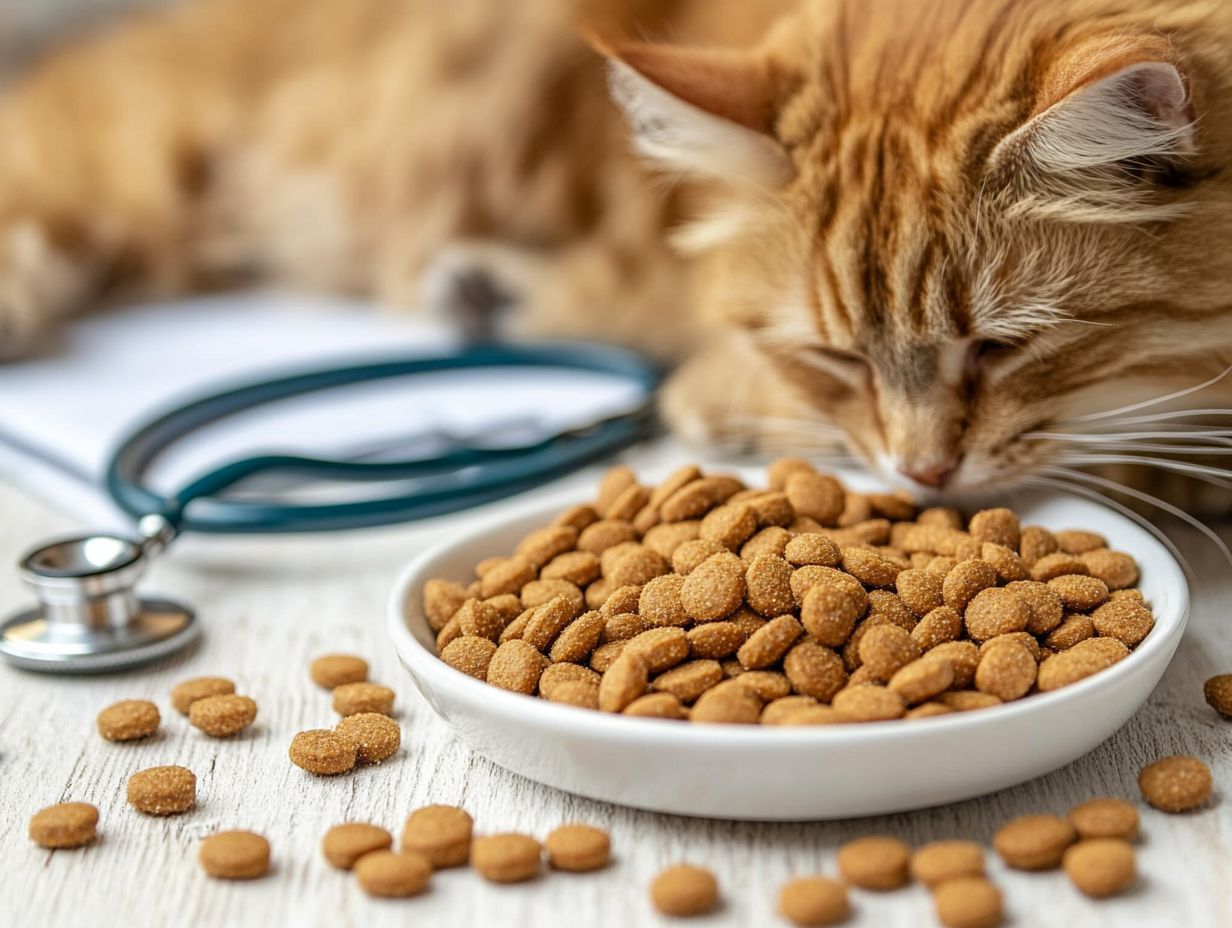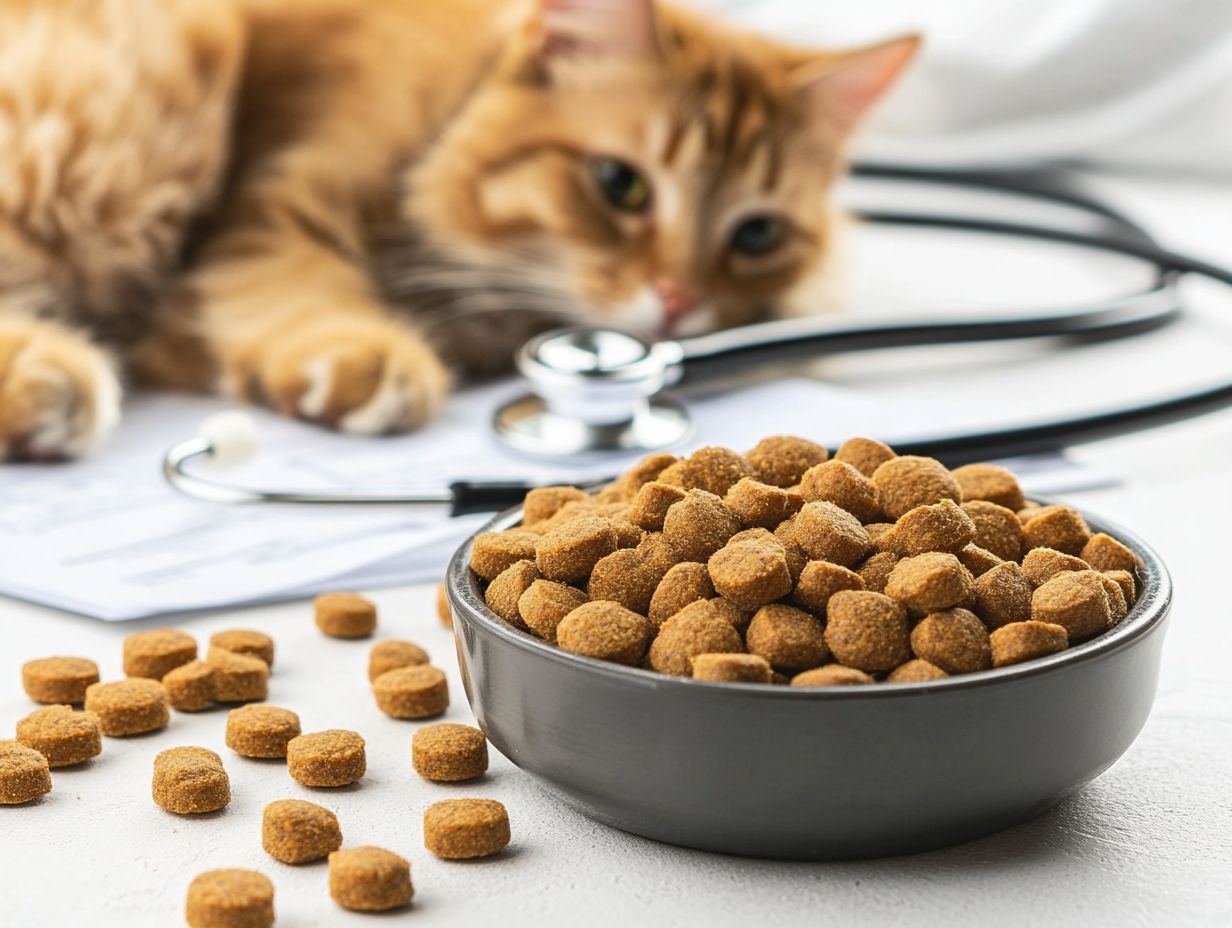Understanding joint health is crucial, especially for our furry friends, as it can prevent conditions like cat arthritis. It is essential for cat owners to be informed about potential risks and benefits associated with dietary approaches for managing arthritis.
Arthritis is a common ailment in cats, affecting their mobility and overall quality of life. However, recognizing signs of arthritis goes beyond just mobility issues; behavioral changes or decreased grooming can also indicate discomfort.
This article explores the various types of cat arthritis, its causes, symptoms, and effective treatment options. It will also discuss how to help your cat manage arthritis through lifestyle changes, exercises, and specialized diets, including an arthritis diet.
Dive in to discover ways to enhance your cat’s comfort and wellbeing through joint care and proper nutrition. Before making any dietary changes, it is always advisable to consult with veterinary professionals.
Key Takeaways:

What Is Joint Health and How Does it Affect Older Cats?
Joint health refers to the overall well-being and functionality of the joints in the body, a factor that is particularly crucial for cats as they age. By maintaining good joint health in older cats, owners can help prevent or alleviate the symptoms of arthritis, allowing their feline companions to remain active and comfortable. For more information on managing arthritis in cats, check out this resource on prescription cat foods for arthritis management.
What Is Arthritis?
Arthritis is a degenerative joint disease that affects many older cats. This condition is marked by inflammation and pain in the affected joints, which can ultimately result in a decreased range of motion and mobility, highlighting the importance of addressing symptoms of arthritis early on.
Osteoarthritis is a specific type of arthritis that develops in aging cats and is characterized by the breakdown of cartilage surrounding the joints. This deterioration can lead to a variety of symptoms in cats, including limping and reduced activity levels.
Understanding the nature of arthritis in cats is essential for adopting a proactive approach to their joint health.
What Are The Different Types Of Arthritis?
There are several types of arthritis in older cats, with osteoarthritis being the most common. This condition develops due to gradual wear and tear on the joints over many years. Inflammatory arthritis can also occur in cats and may cause significant discomfort and pain. Understanding the differences between these types of arthritis is essential for selecting the most effective treatment and management options to improve joint health.
The major distinctions between osteoarthritis and inflammatory arthritis in cats are as follows:
- The onset and progression of osteoarthritis symptoms are gradual and subtle.
- Most cat owners notice that their pets become stiffer and less mobile, engaging in play and physical activities they once enjoyed less frequently.
- In contrast, inflammatory arthritis can present with more acute symptoms and is often associated with infections, making accurate diagnosis critical, sometimes requiring inflammatory supplements for management.
The treatment approaches for these two types of arthritis differ significantly. Osteoarthritis is typically managed through weight loss, joint supplements, and pain relief. In contrast, inflammatory arthritis may require more aggressive treatments, including corticosteroids and immune-modulating drugs.
Understanding the differences between these two types of arthritis and their management options is crucial for caregivers, as it can significantly impact the quality of life for their cats. Working with a veterinary nutritionist can help tailor a homemade diet incorporating omega-3 fatty acids, which are essential for inflammation management. Sources of omega-3 include fish oil and algal oil; consult your vet for recommended dosages and potential side effects.
What Causes Arthritis?
Arthritis in cats can be attributed to various causes, with age being the most common factor. As cats grow older, the natural wear and tear on their joints becomes more pronounced. Weight management is crucial, in alignment with the latest feline obesity guidelines, to support joint health.
Other contributing factors include obesity, which adds extra weight to the joints, previous injuries to the joint, and genetic predispositions that certain breeds may have. Understanding these causes can help in implementing preventative measures to promote better joint health in elderly cats.
How Does Age Affect Arthritis?
As cats age, changes in their joints increase the likelihood of developing arthritis, negatively impacting their joint health. Aging contributes to the breakdown of cartilage tissue, leading to increased friction in the joints and exacerbating arthritis symptoms.
For cat owners, understanding the link between aging and arthritis is crucial to ensuring the health of their senior cats. With aging often comes a natural decline in physical activity and changes in metabolism, which can lead to obesity and further stress already damaged joints.
Regular veterinary examinations are essential, as they allow for the early detection of arthritis symptoms, such as limping or difficultly jumping. Dietary modifications, such as adding omega-3 fatty acids (specifically EPA and DHA from sources like fish oil) to the diet, can help lubricate the joints, while maintaining a proper diet and exercise regimen is vital for keeping a normal weight. Always consult with a veterinarian before making any changes to your cat’s diet.
By being aware of the signs and implementing preventative care measures, cat owners can significantly improve the quality of life for their aging pets.
What Are The Risk Factors For Developing Arthritis?

The most common risk factors for arthritis in cats include obesity, prior joint injuries, and genetic predispositions in certain breeds. Obesity is particularly concerning, as excess weight can place additional stress on the joints. Understanding these risk factors is essential for the preventive management and maintenance of joint health in senior cats.
- Obesity: Proper nutrition and maintaining a healthy weight are crucial, as extra pounds can exacerbate joint stress. Pet owners should collaborate with their veterinarian to develop an appropriate feeding plan tailored to their cat’s needs.
- Joint Injuries: Creating a safe environment is vital for minimizing the risk of falls or accident-related injuries.
- Exercise: Regular low-impact exercise, such as gentle play with a laser pointer or short, slow walks, is important for maintaining muscle strength and flexibility without straining the joints.
- Veterinary Care: Routine veterinary examinations are essential for detecting early signs of arthritis.
What Are The Symptoms Of Arthritis?
Symptoms of arthritis in older cats can vary from one cat to another, but they commonly include joint pain, inflammation, and decreased mobility.
Affected cats may show reluctance to exercise, have difficulty jumping, or exhibit observable behaviors such as changes in activity levels or hiding. Recognizing these symptoms promptly can lead to better management strategies and an improved quality of life for arthritic cats.
What Are The Signs Of Joint Inflammation?
Signs of joint inflammation in older cats can manifest through swelling, tenderness in the affected area, and noticeable difficulty with movement, all of which indicate a worsening of their arthritis condition. Owners should watch for signs like limping or refusal to engage in activities that may cause discomfort.
Changes in grooming habits are also important to note, as pain and discomfort can prevent cats from grooming themselves properly. Additionally, the way a cat rests or any indications that they avoid jumping can serve as valuable indicators of joint issues.
To assist veterinarians in accurately diagnosing the extent of joint inflammation, owners should maintain a journal documenting any behavioral changes they observe, including frequency of vocalizations and specific activities avoided. These symptoms can help veterinary experts develop a more comprehensive treatment plan that not only addresses the arthritis but also aims to enhance the overall quality of life for the cat.
What Are The Symptoms Of Joint Pain?
The symptoms of joint pain in older cats are often reflected in behavioral changes. Signs such as limping, reluctance to jump, or vocalizing during movement can indicate discomfort associated with arthritis. Since these signs can be subtle initially, it is crucial for owners to closely monitor their cats’ mobility and activity levels. Additionally, pet owners should be cautious about any supplements they consider and should consult their veterinarian to ensure their safety and effectiveness.
Proper Food Storage and Handling
It is essential to store cat food properly to maintain its nutritional quality and safety. Always keep food in a cool, dry place and seal it tightly to prevent spoilage. Check expiration dates regularly and discard any food that looks or smells off.
For instance, a cat that once eagerly chased toys may become hesitant to play, while a cat that used to explore the house may now prefer to lie down in one spot for extended periods.
Another significant behavior to observe is the cat’s grooming habits. If a cat stops grooming areas that are typically easy to reach, such as its paws, it may suggest that joint discomfort is hindering normal routines. Additionally, pet owners should pay attention to their cat’s movements when going up and down stairs or entering and exiting the litter box, as these actions can provide further insight into the severity of their pain.
To assist in this monitoring, it can be helpful for pet owners to maintain a log of their observations regarding behavioral changes. Regular veterinary check-ups are also essential to effectively manage the effects of arthritis and ensure the cat receives appropriate pain management.
What Are The Symptoms Of Joint Stiffness?
Joint stiffness in older cats is often observed when they struggle to rise from a resting position or show a lack of agility while moving. These signs are symptoms of arthritis, often requiring careful management.
Stiffness may worsen after periods of inactivity, highlighting the importance of regular exercise. These furry companions may also have difficulty performing everyday tasks, such as jumping onto furniture, climbing stairs, or even grooming themselves.
As stiffness increases, it can lead to decreased mobility and potential discomfort in arthritic joints, both of which should be monitored closely by their guardians. The connection between stiffness and arthritis is significant; as inflammation in the joints escalates, so do the symptoms.
A comprehensive approach that includes appropriate exercise routines, joint supplements like glucosamine chondroitin, and weight management is essential for reducing stiffness, improving mobility, and ultimately enhancing the quality of life for these beloved animals.
How Is Arthritis Diagnosed?
The diagnosis of arthritis in cats involves a comprehensive approach by the veterinarian. This process includes reviewing the cat’s medical history, conducting a physical examination, and utilizing imaging techniques to assess the condition of the joints.
How Is Arthritis Treated?

The treatment of arthritis in cats may involve various approaches, including the use of NSAIDs to manage pain and joint supplements like glucosamine and chondroitin that support joint health. However, it is crucial to consult a veterinarian before introducing any supplements or medications, as they can provide personalized advice based on the cat’s specific condition and overall health.
Additionally, a weight loss diet, possibly incorporating omega-3 fatty acids, may be recommended to alleviate stress on arthritic joints, enhancing both mobility and comfort. It’s important to monitor cats for any adverse reactions during treatment with NSAIDs, as they can have potential side effects, including gastrointestinal distress.
What Are The Treatment Options For Arthritis?
There are various treatment options available for managing arthritis in cats, including NSAIDs for cats such as Buprenorphine for pain relief and joint supplements like glucosamine and chondroitin that support joint health. Joint supplements and prescription diets work together to manage arthritis effectively.
Anti-inflammatory supplements and dietary changes, including the use of prescription diets, can significantly relieve symptoms and enhance the quality of life for arthritic cats. Exploring the effectiveness of these treatments reveals a complex landscape; for instance, while NSAIDs can reduce inflammation and alleviate discomfort, they may also have side effects.
Joint supplements like glucosamine and chondroitin present an alternative that may assist in repairing cartilage, although their effectiveness can vary among individual felines. Additionally, certain dietary adjustments, including the incorporation of omega-3 fatty acids from cold water fish, can improve joint function.
It is essential to consult a veterinarian when selecting these treatment options, as they can provide personalized advice based on the cat’s specific condition and overall health.
Signs of an allergic reaction to ingredients in prescription diets may include vomiting, diarrhea, skin irritations, or excessive scratching. Common allergens often include specific proteins or grains. Pet owners should monitor their cats closely when introducing new diets.
What Are The Prescription Cat Foods For Arthritis Management?
Prescription cat foods designed for arthritis care, such as Hill’s Prescription Diet and brands like Nutramax, are specially formulated to provide optimal nutrition and include ingredients high in omega-3 fatty acids and other nutrients that support joint health.
These prescription diets can help improve symptoms and enhance the quality of life for cats with arthritis. Incorporating nutrients like glucosamine and chondroitin into a prescription diet supports cartilage health and mobility, which are vital for active participation in daily activities and maintaining a healthy weight.
To maintain an appropriate weight for cats, pet owners can implement portion control, monitor calorie intake, and encourage regular exercise aligned with the latest feline obesity guidelines. Environmental enrichment, such as interactive toys and climbing structures, can promote physical activity in arthritic cats.
When storing prescription cat food, ensure it is kept in a cool, dry place in an airtight container to maintain its nutritional integrity and prevent spoilage.
While certain diets may help with arthritis management, they should not replace veterinary care or prescribed treatments, as ongoing medical supervision is crucial for managing the condition effectively.
Also, it’s important to recognize the unique nutritional needs of different life stages, including kittens, senior cats, and pregnant or nursing cats, regarding joint health and arthritis management.
Selecting a prescription diet should involve a veterinary nutritionist or a veterinarian specifically trained in feline nutrition, along with consulting resources like PetDiets.com and BalanceIT.com, to ensure that the recommendations are tailored to the cat’s specific health status and dietary requirements. When formulated correctly, the inclusion of these essential nutrients helps alleviate discomfort and supports overall well-being.
How Can You Help Your Cat With Arthritis?
Assisting a cat with arthritis can be achieved by implementing lifestyle changes that significantly enhance their quality of life and support joint health, such as providing an arthritis diet or a homemade diet based on veterinary advice to ensure they meet the cat’s specific nutritional requirements.
Simple adjustments, such as providing a comfortable resting space, ensuring easy access to food and water, and incorporating a weight management plan that prioritizes a high-quality, animal-source protein to align with cats’ obligate carnivore nature, can all help reduce discomfort and maintain muscle mass.
What Are The Lifestyle Changes That Can Support Joint Health in Cats With Arthritis?
Lifestyle changes can play a crucial role in managing arthritis in older cats, promoting both joint health and overall well-being. Key interventions may include:
- Creating a warm and easily accessible resting area
- Ensuring regular gentle exercise
- Making dietary adjustments tailored to their specific health needs
These dietary changes might involve incorporating supplements such as omega-3 fatty acids, which can help reduce inflammation. However, the use of supplements should always be discussed with a veterinarian to ensure safety and appropriate dosage, as well as closely monitoring their weight to prevent additional strain on their joints. Providing a warm environment, perhaps with heated beds or blankets, can also alleviate stiffness in muscles and joints.
Regular veterinary check-ups are essential for ongoing monitoring and adjustments to the management plan. Establishing a consistent routine will help integrate these changes into the cat’s daily life, providing predictability that is particularly important for elderly pets while optimizing their comfort and mobility.
What Are The Exercises That Can Help With Arthritis?
Regular low-impact exercise is one of the best ways to manage arthritis in older cats, as it helps preserve joint health and mobility. Gentle stretches, short walks, and interactive play are effective activities that strengthen muscles, reduce stiffness, and promote a healthy weight, especially when combined with appropriate dietary modification. Any exercise regimen should be discussed with a veterinarian, especially for cats with existing health issues.
Additional exercises that maintain joint movement without placing excessive stress on sore joints include:
- Gradual climbing on soft surfaces,
- Playing with feather wands, and
- Using treat-dispensing toys.
These exercises should be introduced gradually, allowing the cat to build up to them and avoiding any sudden movements that might cause pain or discomfort. Owners should always watch for signs of discomfort and adjust the exercises accordingly.
The goal is to establish a routine that encourages movement and exercise while protecting joint integrity, ultimately leading to improved physical and emotional health.
How Can You Make Your Home More Comfortable For Your Arthritic Cat?

Creating a comfortable home for an arthritic cat involves making modifications that enhance their mobility and overall comfort. Simple solutions such as providing soft bedding, limiting stairs, and ensuring easy access to food, water, and litter can significantly improve their quality of life. Ramps without steps can help reduce strain on their joints, and placing food and water bowls at accessible heights, such as on low tables or stands, can ensure ease of access and safety for the cat.
Observing the cat’s behavior and preferences is crucial in determining what changes will be most beneficial. If you notice that your cat is hesitant to navigate higher areas, it may be wise to keep their favorite spots closer to the ground. Heated mats can also be a great addition, but they should be monitored for safety to prevent overheating, ensuring they are suitable for prolonged use by arthritic cats.
Additionally, positioning litter boxes for easy access, possibly with low-entry frames, is essential for their well-being and health. By actively modifying the home environment to meet these needs, you can greatly enhance your furry friend’s daily life.
Frequently Asked Questions
What is joint health and why is it important for cats?
Joint health refers to the well-being and proper functioning of the joints, which is vital for a cat’s mobility and quality of life. Maintaining joint health through a balanced diet rich in animal-source protein and appropriate nutrient levels is essential for preventing joint deterioration and managing conditions like arthritis.
When making dietary adjustments for an arthritic cat, it’s important to monitor for any allergic reactions to new foods or supplements, emphasizing the importance of gradual changes.
Joint health refers to the condition and function of a cat’s bones, muscles, and connective tissues that make up their joints. It is important to maintain good joint health in cats to prevent pain, discomfort, and mobility issues, especially as they age.
What is arthritis and how does it affect cats?
Arthritis is a joint disease that causes inflammation and pain in the joints. It can affect cats of any age, but is more commonly seen in older cats. Arthritis can make it difficult for cats to move around and perform daily activities, leading to a decrease in their quality of life. It’s crucial to note that while dietary management can help, it should not replace veterinary diagnosis or treatment for arthritis.
How can prescription cat foods help manage arthritis in cats?
Prescription cat foods for arthritis management are specifically designed to support joint health and mobility in cats. They often contain ingredients such as glucosamine and chondroitin, known to promote healthy joints, as well as omega-3 fatty acids, which have anti-inflammatory properties to reduce joint pain and inflammation. Ensure that any prescription food adheres to AAFCO standards and guidelines, confirming safety and nutritional compliance.
Can all cats benefit from prescription cat foods for arthritis management?
While all cats can benefit from a healthy diet to maintain good joint health, prescription cat foods for arthritis management are specifically formulated for cats with arthritis or those at risk of developing it. If your cat has been diagnosed with arthritis, these foods may be recommended by your veterinarian to help manage their condition. Always consult with your veterinarian before starting any new diet.
Are there any potential side effects of using prescription cat foods for arthritis management?
Prescription cat foods for arthritis management are typically safe for cats to consume. However, some cats may have sensitivities or allergies to certain ingredients, leading to symptoms such as vomiting, diarrhea, or skin irritations. It is important to consult with your veterinarian before starting your cat on any new diet to ensure it is the best option for them. Improper transitions from a standard diet can lead to nutrient deficiencies.
How long does it take to see results from using prescription cat foods for arthritis management?
Results may vary depending on the severity of your cat’s arthritis and their individual response to the food. In general, it may take a few weeks to a few months before significant improvements in joint health and mobility can be observed. Older cats often experience symptoms of arthritis, including stiffness and pain. An arthritis diet, rich in omega-3 fatty acids and glucosamine chondroitin, can support joint health. It is important to follow your veterinarian’s recommended treatment plan and monitor your cat’s progress closely. Consider keeping a detailed record of any changes in behavior or health conditions after dietary adjustments. Consult with a veterinary nutritionist for personalized advice on dietary modifications and the best protein source to maintain muscle mass. Gradual weight loss is crucial for overweight cats, as rapid weight reduction can lead to health complications. Additionally, it is essential to ensure that any supplements or medications, such as NSAIDs, are introduced only under veterinary guidance due to potential side effects. Explore options such as Nutramax Dasuquin, Cosequin, and foods rich in cold water fish, containing DHA and EPA, for further support. For more personalized homemade diet plans, visit PetDiets.com or BalanceIT.com. Always emphasize the necessity of veterinary consultation to ensure proper nutrition and to avoid deficiencies when considering raw or homemade diets. Proper storage of prescription diets is also vital; ensure they are kept in a cool, dry place and check for spoilage before feeding.